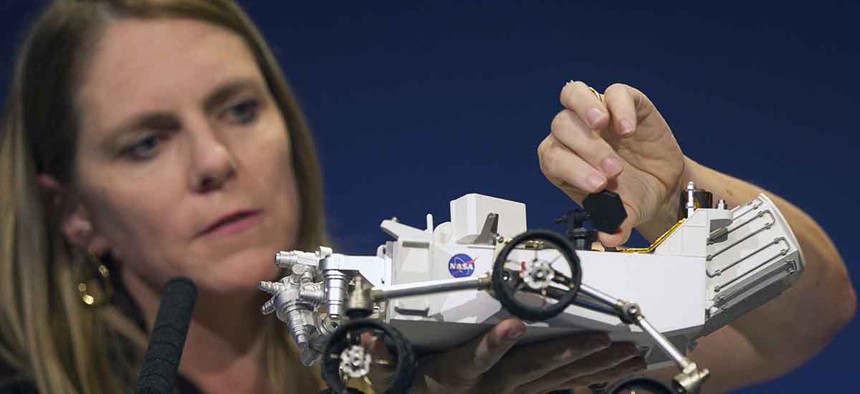How to Become a Rocket Scientist

Jennifer Trosper, Mars Science Laboratory, MSL mission manager, JPL, adjusts the high-gain antenna on a rover model during a news briefing on the last data and imagery from Sol 1 at NASA's Jet Propulsion Laboratory. Damian Dovarganes/AP
For would-be scientists and engineers underrepresented in those fields, interning at NASA’s Jet Propulsion Laboratory is often a key first step.
CJ Giovingo’s path to becoming a flight system verification and validation engineer at NASA’s Jet Propulsion Laboratory wasn’t a straight line.
Giovingo studied astrophysics in college but didn’t complete a degree. Instead, they got into political organizing, working with groups that focused on environmental rights, LGBT issues, and unions. Then, they left organizing and installed solar panels in North Carolina.
That experience, Giovingo said, made them want to become an engineer. Giovingo began taking community college classes at night and eventually transferred to Capitol Technology University in Maryland. At a conference, they waited in line at a booth to hand in their resume to JPL and learn more about its internship program, having heard an internship was the best way to get a permanent job at the famed research center.
It worked. Giovingo, then 33, began an internship the following summer. Two months after the internship ended, they started a full-time, salaried role at JPL. Giovingo now works on the newest Mars rover mission, scheduled to launch in 2020.
Giovingo says JPL’s culture was a reason to stick around after the internship ended. “I am a trans person, so [JPL’s] diversity was a really big, important part for me," Giovingo said. "I wanted to know that I was not only accepted, but also that I had a community to grow into.”
Nestled at the edge of the San Gabriel Mountains in Southern California, JPL is renowned for its missions to Mars and other planets, although it also researches space and Earth itself. Working there is a dream for many students who are enrolled in science and engineering programs. JPL is trying to build a more diverse workforce in a field where women and minorities are underrepresented.
Over the 10 or more weeks of the internship, undergraduate and graduate students receive a stipend to work full-time at the campus. Interns get the chance to work on specialized projects, such as developing software to help command the Curiosity rover on Mars, or detecting life in extreme environments. They also attend regular seminars and explore the center’s facilities for spacecraft assembly and testing.
The internship program is competitive—thousands of students apply each year—and growing steadily. A few years ago, JPL hired 300 interns every year; now the number is around 1,000. NASA hosts another 1,800 interns annually at other centers around the country.
To make sure it gets a real diversity of applicants, JPL recruits potential interns in a variety of ways: at job fairs, at science and engineering conferences, and through minority-serving institutions. The center also teams up with organizations such as the National Society of Black Engineers and Society of Women Engineers.
“A lot of times, one of the biggest challenges that we see from students from an underrepresented population is that they don’t think they’re eligible or can compete for these opportunities,” says Jenny Tieu, a program coordinator at JPL’s education office. “Working with external partners and providing pipeline training programs help alleviate some of that.”
JPL offers support and career guidance to students over the course of the internship. If an intern moves on to a permanent role, they can continue to seek advice from the education office and even become a mentor to the next generation of interns.
Tracy Van Houten, a JPL systems engineer currently working on the Mars 2020 rover mission, has mentored dozens of interns over the past 12 years, including Giovingo. When working with interns, she meets with them on a daily basis and encourages them to ask questions and seek more work. A large part of what she mentors them on is professional development skills and how to conduct yourself at the lab, she says.
Interns also learn how to apply what they are learning about in school in the context of a job.
“I think a lot of [the students] leave an internship having a much better idea of their path forward, both in terms of what education time they have left and then into their career,” Van Houten says.
Morgan Leigh Cable, another former intern who became an employee at JPL, says an internship at JPL “completely changed [her] life.” She was living in Florida and working on her undergraduate degree in chemistry when she was accepted into the program. During her internship, she researched how to detect bacterial spores—a form of life that can survive in extreme environments.
After the internship, Cable received her Ph.D. in inorganic chemistry from the California Institute of Technology, an institution in Pasadena that manages JPL for NASA, while continuing her research. At 34, she is now a research scientist on missions to Saturn and Jupiter’s moon Europa. Cable also mentors JPL interns.
Over this past summer, Sarah Kaye, an aerospace engineering student at California Polytechnic State University in San Luis Obispo, was an intern on the Mars 2020 rover mission. The experience, she says, gave her a taste for working on real projects and confirmed her decision to pursue a career in systems engineering after college. She felt supported by Van Houten—her mentor—and other women leaders at the campus.
“The flight system systems engineering team I worked with had a lot of female leaders,” she says. “This was very encouraging as a female in engineering. At school [it’s] only about 10 percent women in my major. One day, I want to be [a leader] like these remarkable women.”
NEXT STORY: The Urban Drone Invasion is Nigh





